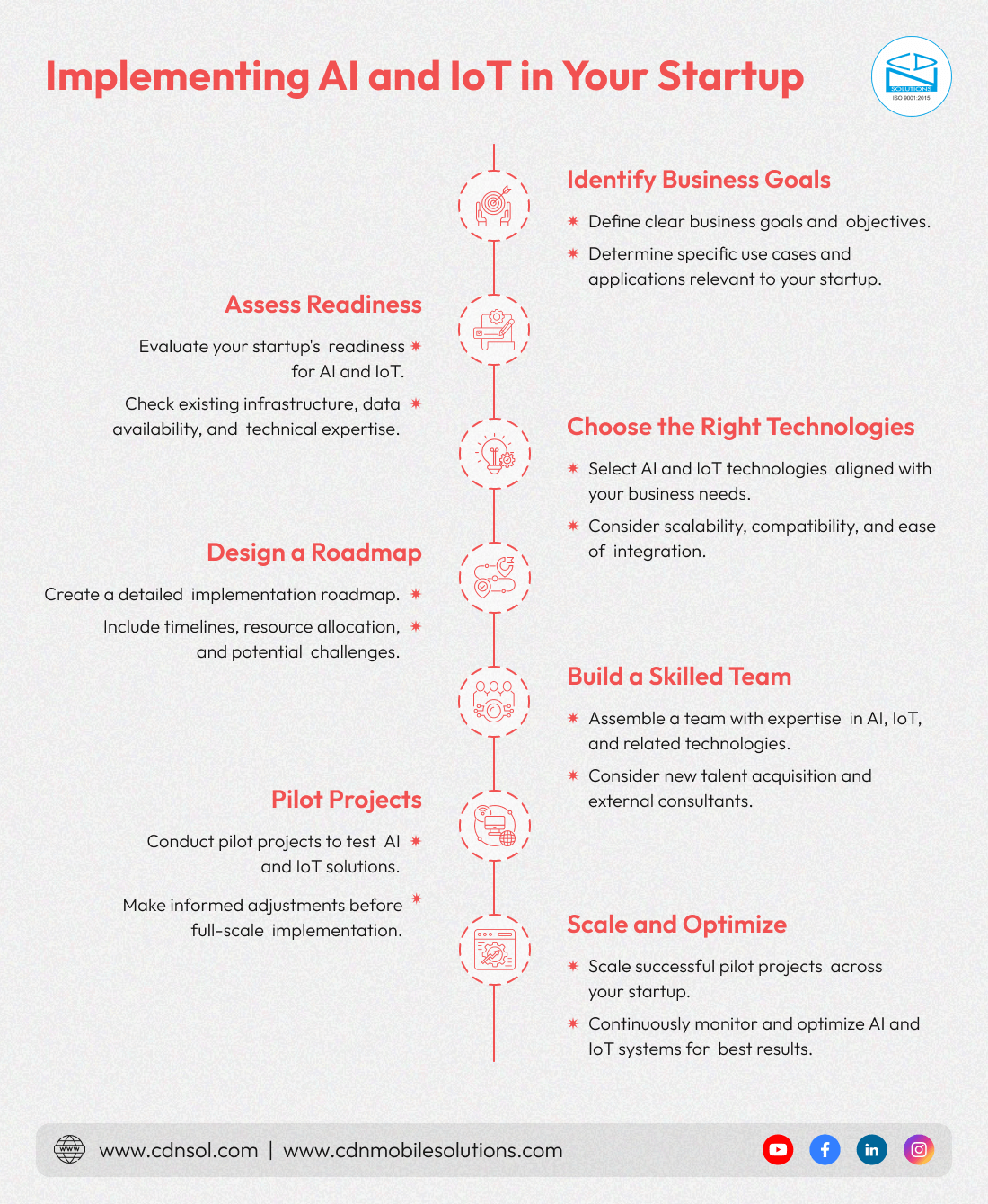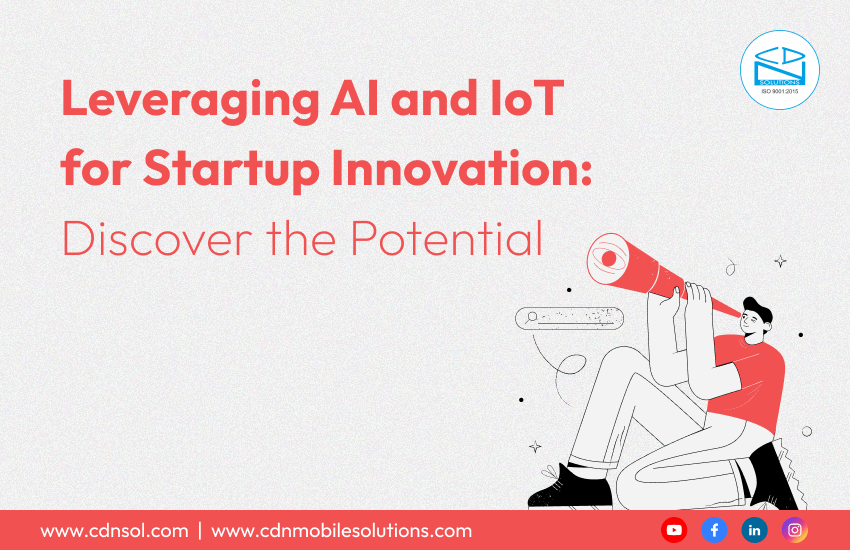From an idea, it has grown into a disruptor. It is disturbing industries worldwide. Nothing seems to have an exemption from the dramatic changes that AI technologies are presenting to IT, entertainment, health, and all other sectors. AI provides startups with the power to challenge big companies.
AI companies flourish because big data, enhanced computing powers, and advanced machine learning techniques assist businesses in making innovations, smooth workflow, and finding revenue opportunities.
The innovative nature and flexibility make a startup the ideal space for opting for Artificial Intelligence. Its ability to move first into the most modern technologies enables such organizations to be at the forefront of implementing AI by creating new markets and strategies.
With time, today’s technological world changes fast, and for any startup, staying ahead of the curve has to be achieved through creative solutions. Concerning this, IoT and artificial intelligence turn upside down the basic functioning and value generation mechanism of any startup. Any startup with the help of AI and IoT can achieve unprecedented inefficiency, production, and customer satisfaction.
Table of Contents
Understanding AI and IoT
Artificial intelligence refers to human brain intelligence being replicated in a machine, which is programmed to think, learn, and deliver like a human being. It therefore involves technologies to make machines do things like pattern recognition, decision-making, and language comprehension, including Machine Learning, Natural Language Processing, Computer Vision, and Robotics.
Short for the Internet of Things, IoT is a system of interrelated devices that can be accessed via the Internet or communicate through networking connectivity. The Internet of Things refers to anything man uses—from wearables and smartphones to industrial gears and home appliances; in any aspect though, the devices are interconnected. Internet of Things devices communicate, share, and analyze data at the end, making decisions and processing.
The Synergy Between AI and IoT
AI and IoT, juxtaposed, come up with a powerful synergy that elevates the potential of both technologies. On its part, IoT produces enormous amounts of data from connected devices, while on its part, AI lends a hand with tools for analysis and deduction of meaningful insights from that data. Such synergy puts any startup on the pathway to building intelligent systems capable of learning, adapting, and making informed decisions in real-time.
Benefits of Integrating AI and IoT
- Improved Data Analysis: IoT devices generate huge amounts of data. AI processes this bulk of data to come up with many useful insights. This blend thus fits the bill for any startup looking to drive its operations with data-driven decisions.
- Predictive Maintenance: IoT sensor data can be analyzed by AI-powered predictive analytics to project maintenance needs and equipment failures. This helps the startup economize, extend the life of their assets, and reduce downtown.
- Automation and Efficiency: AI algorithms automate routine tasks and processes, while IoT devices trace and manage physical systems. Merging these would mean greater efficiency, fewer human errors, and higher productivity.
- Personalization: Analysis of data from the IoT devices to understand user behavior and preferences. This helps startups provide personalized experiences, hence improving customer satisfaction and loyalty.
- Real-Time Decision Making: IoT provides real-time data from the connected devices, while AI processes that data to make instant decisions. This becomes very useful in dynamic environments where quick responses matter.
Applications of AI and IoT in Startups
Smart Healthcare
AI and IoT can be game-changers in health care for remote monitoring of patient conditions, personalized treatment, and predictive analysis. How? The startups in this vertical would leverage these technologies to improve patient outcomes and operational efficiency.
- IoT devices, such as wearable sensors, can track the physiological parameters of a patient constantly and transmit them to healthcare practitioners. AI algorithms will slice and dice the data for abnormalities and trigger doctors to manage health issues.
- AI can digitalize data from patients, thereby spotting patterns and providing the best advice concerning the treatment of each patient. This ensures that every individual patient gets the most perfect and tailor-made care.
- Using data analytics from IoT devices, AI can track pathogens, patient deterioration, and many other health trends to deliver proactive interventions and better resource allocation.
Smart Manufacturing
Industry 4.0 is AI and IoT integrated into manufacturing to transform traditional ways of producing and delivering products. Integration of such technologies by manufacturing startups is the key to scaling production efficiency, cost reduction, and high-quality products.
- By using IoT sensors, the condition of machinery and equipment can be tracked in real-time. AI algorithms analyzing that data can predict when maintenance will be required, avoiding unexpected breakdowns and reducing downtime.
- AI-driven computer vision systems can check for product defects as they come off the manufacturing line. The result is high-quality standards, with far fewer defective products making their way to customers.
- AI can leverage data from IoT devices across the value chain to pinpoint bottlenecks and inefficiencies. It helps a startup optimize its inventory, lead times, and finally, the overall performance of supply chains.
Smart Cities
AI and IoT are therefore rapidly becoming the most prominent enabling arena of smart city initiatives, which work on enhancing citizens’ quality of life through better infrastructure, services, and sustainability. Therefore, it implies that startups can have a contributory role in the development and implementation of end-to-end smart city solutions.
- IoT sensors can monitor traffic flow and congestion in real-time, and AI algorithms analyze data to optimize these signals, having fewer congestions and overall better management of traffic.
- IoT devices can track energy consumption in buildings and other infrastructures. AI processes this information for efficient use of energy, reduction of waste, and sustenance.
- Artificially intelligent surveillance systems examine data from cameras and sensing IoT devices for the detection of suspicious activities and risk estimation in public safety applications. This helps provide a fast response in emergencies and aids in improved safety.
Smart Retail
The retail sector uses AI and IoT to create better customer experiences, enhancing its operation efficiency for higher sales. Retail startups can leverage such technologies to gain a competitive edge.
- AI analyzes all information from all kinds of IoT devices including smart shelves and customer tracking systems to understand customer behavior and preferences and develop personalized recommendations, offers, etc.
- While IoT sensors can track inventory levels in real-time, the data gathered can be analyzed by AI algorithms to ensure optimal stock is maintained in inventory, prevent overstocking and stock-outs, and optimize inventory turnovers.
- By allowing checkouts to be performed automatically, computer-vision AI systems make traditional cashiers almost obsolete. It creates a new revolution in the shopping experience while improving customer waiting time.
Smart Agriculture
AI and IoT make agriculture perform differently in terms of precision farming, yield optimization, and reduction of resource utilization. These technologies can be utilized for creating innovation and sustainability within agri-startups.
- IoT sensors track soil conditions, weather patterns, and crop health in real time. AI algorithms analyze that sea of data for actionable insights on how to optimize planting, irrigation, and fertilization.
- AI-encoded computer vision systems can process images from drones and cameras for crop diseases and pests to enable action, thereby ensuring early intervention and significantly reducing crop losses.
- IoT devices track the irrigation pattern, quantity of energy consumed, and other farming resources. AI uses this data to optimize the usage of resources to allow minimal wastage and achieve sustainability in farming.
Implementing AI and IoT in Your Startup

Challenges and Considerations
- Data Privacy and Security: AI and IoT, as technologies, involve the collection and analysis of vast amounts of data. Robust data privacy and security may be borne in mind while structuring a startup to enable it to achieve protections that are proportional to the value of the sensitive information.
- Integration with Existing Systems: Ideally, the approach to implementing AI and IoT solutions needs to be integrated into the current systems and processes. Startups must consider ways to effectively integrate the technology in a way that doesn’t interfere with normal operations.
- Cost and Resource Constraints: In essence, AI and IoT might be very resource-intensive and rather demanding in terms of technology, infrastructure, and investment in talent. This means start-ups have to strategize around the expenditures and resources so that they don’t overreach.
- Regulatory Compliance: Depending on the nature of the business and geographical location, there are regulatory requirements and compliance standards that apply to the implementation of AI and IoT solutions for a startup. Ensure that your startup knows about them and complies with them.
- Scalability: The AI-/ IoT-based solutions shall have the characteristics of scalability — as your startup grows — to be able to meet the requirements. Be ready for scalability during the early phases of working, so you are not held by limitations and performance pitfalls later on.
The Future of AI and IoT in Startups
The future of AI and IoT in startups is very promising, with new improvements and innovations coming up every second. A few major trends that one might look out for are given below:
- Edge Computing: Edge computing simply means the processing of data at the ‘edge’ or closer to its source, rather than at some centralized cloud servers. This helps in lesser latency and faster real-time decision-making. Startups can utilize edge computing to improve their AI and IoT systems’ performance and responsiveness.
- AI-Powered Automation: AI-powered automation is only going to become more sophisticated, as the next wave in machine-learning algorithms means more autonomy and intelligence for machines. Startups can gain increased automation in areas such as customer service, manufacturing, and logistics.
- 5G Connectivity: 5G connectivity is expected to be faster and more reliable, considerably improving the capability of IoT devices. Faster and more reliable connectivity will help such startups deploy greater, complex, and data-intensive IoT solutions that drive innovation in diversified industries.
- Improved Security Measures: Security concerns will surge higher: Besides cyber threats, with rising AI and IoT, there will be an increased effort on the part to enhance the security measures against such threats. This would mean that startups would have to implement advanced technologies and practices in security to protect their AI and IoT systems from associated risks.
- Ethical AI: AI ethics is well in the limelight, and the world needs fairness, transparency, and accountability in AI systems. This means that startups should pay significant attention to the ethical dimension when developing and putting AI solutions into practice.
- Sustainable IoT: Sustainability in IoT is increasingly front and center, with the trend gearing toward green, connected devices with lesser environmental impacts. Sustainable practices in IoT can help leverage environmental responsibility as a differentiator for startups to drive positive social change.
Conclusion
By and large, it is in the combination of AI and IoT that a startup stands to achieve innovation, efficiency, and value creation opportunities. These technologies can differentiate the startup, enhance customer experience, and meet business goals from a technological point of view.
Although applying AI and IoT presents challenges and considerations, the benefits far outweigh the risks. It is only through careful planning, strategic implementation, and lastly, ongoing optimization that any startup will be able to unleash the potential of AI and the IoT for operational transformation that provides long-term success.
At CDN Solutions, we are experts at guiding fledgling businesses through the challenges of implementing AI and IoT. Our team of professionals is committed to offering creative, scalable solutions that are customized to your particular business requirements. Get in touch with us right now to find out how we can help you realize your full potential and use AI and IoT for startup innovation.
Also read: How IT Infrastructure Can Make or Break Your Startup
Also read: Custom Software vs. Off-the-Shelf Solutions: What’s Best for Your Startup?

